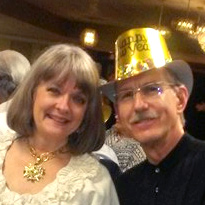Even after 8 years, this still sometimes happens to me too. What I tell the beginners I teach is a little different from most of the answers here... Obviously, beginners use the "basic" step of the dance as a fallback. Sounds like you are already doing that, and the suggestions that you add 'style' to them are good. What you need to do next though is twofold:
a) make sure that you're confident enough in your basic that you can think ahead while dancing it. You are probably already doing this, but even people with a few years of lessons sometimes still don't completely have this down. Add to that the leads stress of floorcraft in social contexts, and suddenly it starts getting very difficult.
b) assuming you already have a), the next step is to add steps or small patterns to the things you can dance without thinking.
Let's say you have waltz. Beginners learn a closed change and a box step. Once they get their feet going, in international they learn "basic amalgamation" (Basic amalgamation is a natural turn followed by a closed change, then a reverse turn, another closed change). This is the real "basic, nonthinking" pattern. So let's say you can do this, but you're struggling to lead more. Pick a move, and focus on flowing into and out of it from basic amalgamation. Some good options are:
Whisk to promenade and chasse
natural hesitation change (good choice because it leads to many other moves)
natural spin turn
outside changes to open or closed position
(good choice because it forces you to have a strong lead)
basic weave (good choice because it is extremely useful for floorcraft)
So, pick one of these and work to add it to your repertoire as a move that you don't have to think to dance. For a little while you'll feel like you're dancing mostly basic and one more move; that's ok! Your goal here is expand what your brain thinks of as "basic": the things your body can automatically and easily switch between with no thought, even when your brain is trying to recall what the heck other moves you know, 'cause it's gone and frozen!

After some practice, you'll be able to easily add, say, outside changes to your repertoire of "basic" and you'll be able to use them just as easily as the rest of basic amalgamation. Now pick another move. Now is a great time to look at the charts of "followed by" and "preceeded by". As you integrate another move into your muscle memory, focus on adding it in different places of what is your brain's new "basic steps", and check whether you can exit the new move into different parts of your "basic steps".
So for example if you've got natural hesitation change in your repertoire of "basic moves", and you decide to add Basic Weave. You enter basic weave after an underturned reverse turn. Your "basic" includes two ways of achieving that: in basic amalgamation after a natural turn and closed change OR after a hesitation change. So you want to practice both of those entries into the weave until it becomes second nature.
I hope this isn't too wordy and you find it helps a bit. Feel free to reach out; teaching people from beginner to bronze-ish level is where much of my passion lies!


